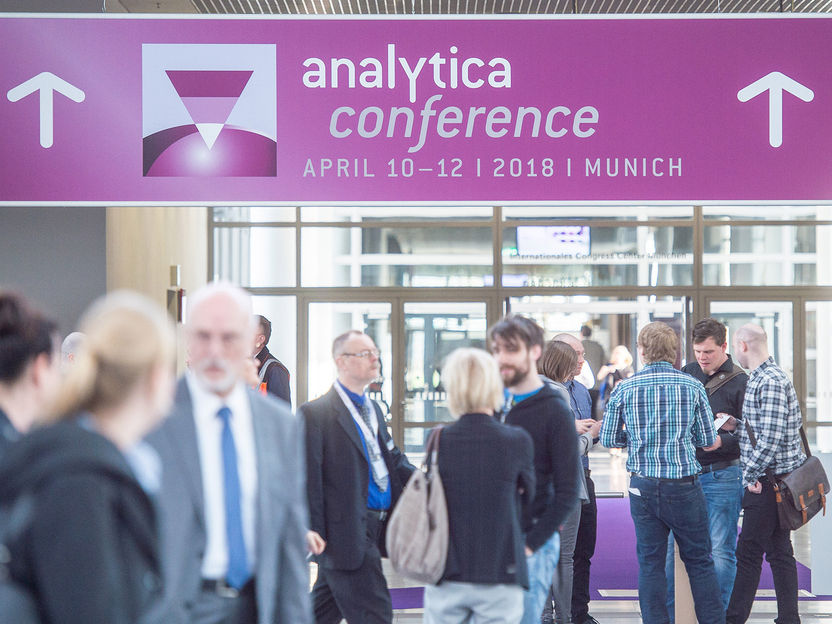analytica closes with record-breaking visitor attendance
-
analytica 2018 as the largest platform for digital transformation in the lab

Strong analytica conference 2,074 participants learned about the hottest scientific topics in the industry
Messe München
most international analytica in history
analytica conference with new all-time highs
The 26th analytica met with overwhelming interest. In the past four days, some 35,800 visitors from all over the world came to the competitive exhibition of the industry on the Munich fairgrounds. They all wanted to know: Where is the laboratory industry heading? At the leading international trade fair for laboratory technology, analysis and biotechnology, 1,164 exhibitors from 49 countries gave impressive answers to this question.
The brilliant sunshine outside matched the bright mood in the exhibition halls. The throng of visitors from the field, of whom almost 40 percent had come from abroad, filled the halls and drove the number of visitors to a new record high. Dr. Reinhard Pfeiffer, Deputy CEO at Messe München, hence came to a decidedly positive conclusion: “Exactly 50 years ago, the analytica was launched. By now, it has developed into the world’s largest and most important meeting place for the laboratory industry—nowhere else is the laboratory reflected as comprehensively as it is at analytica. Anyone who made his or her way through the five exhibition halls can confirm this impression.”
Siegbert Holtermüller, Advisory Board Chairman of the analytica and Regional Division Manager of Olympus Germany, also sees this development and emphasizes the variety of topics and visitors at analytica: “We had even more visitors at the booth than we had at the analytica 2016, and from a huge variety of industries too. Of course, digitization and automation continue to become more and more important, but naturally visitors are still looking for individual solutions to challenges in analysis and diagnostics.”
Susanne Grödl, Exhibition Director at the analytica, adds: “The great interest in our smart laboratory program shows that digitization has definitely arrived in the lab. In 2020, we will put even more emphasis on this topic.”
The analytica 2018 in figures
The strongest increases in visitor numbers came from China, Austria, Korea, Russia and Japan. The top visitor countries were, apart from Germany (in this order): Austria, Switzerland, Italy, China, Great Britain and the USA. Satisfaction among the visitors is very high, according to a survey by Gelszus-Messe-Marktforschungsinstitut: 99 percent rate the event as good to excellent.
“Every second exhibitor at the analytica 2018 came from abroad. This number underscores the synergy effects in the direction of Munich that emanate from our foreign trade fairs. For international manufacturers who are interested in the European market, Munich is a ’must see’ event”, emphasizes Claudia Sixl, Exhibition Group Director of the analytica network at Messe München.
This high level of approval is also a sign that the industry is doing well. New developments in the health sector are driving growth in the IVD market. In 2017, for example, the Life Science Research department of the VDGH reported an increase of 1.4 percent in laboratory diagnostics.
The same applies to analysis, biotechnology and laboratory technology. “We are looking back at an outstanding year 2017 with a total growth of eleven percent”, said Mathis Kuchejda, president of the SPECTARIS Association for Analysis, Biotechnology and Laboratory Technology. From his point of view, one of the central challenges in digitization in the laboratory is “the uniform device interface, together with the consideration of which data ought to be transferred in the first place, and how data security can be ensured.”
Variegated supporting program with additional crowd puller
The issue of digital interfaces was put to the practical test at the new Forum Digital Transformation in Hall B2, for example in the practice lecture “Smart Laboratory—How does digital networking of laboratories with customers succeed?”
Product presentations were also an integral part of the program at the Forum: Eppendorf, Mettler-Toledo, Thermo Fisher and the members of Nexygen presented smart solutions for the future. For example, Joe Arteaga, Director Connectivity—Laboratory Equipment Technologies at Thermo Fisher, showed how device networking helps to streamline workflows and drive research.
The visitors showed great interest in the individual program items; free seats were scarce. Thus, the premiere of the Forum Digital Transformation already was a great success.
However, not only there was digitization on the agenda: With a total of 59 items on the supporting program, visitors from the field were able to gain such a comprehensive picture of digitization as they could at no other laboratory fair anywhere in the world. The analytica conference reflected this, just as the Personalized Medicine Focus Day did, where there was enormous visitor interest already at the opening discussion with Dr. Friedrich von Bohlen und Halbach, Managing Director and co-founder of dievini Hopp BioTech holding, on Friday morning. This interest continued unabated up to the last discussion panel of the event: “One in a million—your data will be king”.
Karin Hofelich, Publishing Director Life Sciences at GoingPublic Media, organizer of the Finance Day and the Focus Day Personalized Medicine, looked back on two days full of positive impressions: “The Finance Day and the Focus Day Personalized Medicine at the analytica bring capital market and life sciences together. This year, the panel discussion ’Current financing trends in biotechnology’, with the focus on crowdinvesting, attracted a particularly large number of visitors. The mood at both events was very good, and we are looking forward to the next analytica.”
At the two Live Labs, Food Analysis and Material Analysis, the visitors from the field were able to experience other big topics of the industry at close quarters—almost en passant—right in the thick of the exhibition: From detection of glyphosate in tomatoes to short-term or long-term weathering of various materials. Here, too, the visitors’ interest was appropriately high.The Forum Laboratory & Analysis and the Forum Biotech also guaranteed high-level knowledge transfer. Once again, visitors were enthusiastic about the special show Workplace Health and Safety with real-world scenarios on the dangers in the laboratory—including loud “bangs” as results of chemical reactions.
Strong analytica conference
The analytica conference also contributes to the top result: 2,074 participants—an increase by 12.8 percent from 2016—learned about the hottest scientific topics in the industry.
Professor Ralf Zimmermann from the University of Rostock commented on the analytica conference 2018: “The conference program is excellent. We were able to organize a nice international session on aerosol and health this year. The trade fair itself enabled us, as it always does, to meet our various cooperation partners very efficiently.”
Chairs and speakers from Europe, China, Korea and the USA gave lectures on such topics as the use of analytical methods in food chemistry and toxicology, the role of consumer health analysis, and the handling of big data. Here, too, the lectures were often filled to the very last seat.
The next analytica will take place from March 31 to April 03, 2020, on the fairgrounds of Messe München.
The industry will meet next from September 06 to 08 at the analytica Anacon India and India Lab Expo in Hyderabad. From October 31 to November 02, analytica China will then take place in Shanghai.






















































